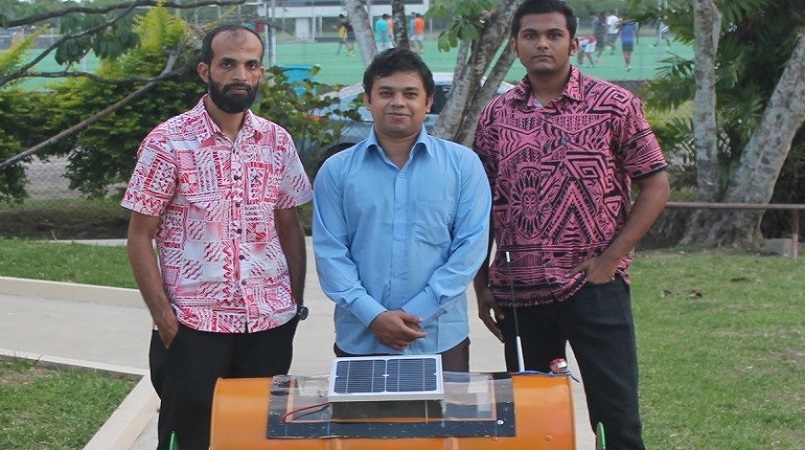
Two staff and a student of The University of the South Pacific have officially received a patent for their invention of a ‘Portable Wave-Solar Energy Harvesting Device’ by Intellectual Property (IP) Australia.
Lecturers Dr F M Rabiul Islam and Dr Kabir Mamun, and student Shaneel Prakash of the School of Engineering and Physics invented the portable device, which presents the concept of a low cost wave-solar generation for Pacific Island Countries.
The ‘Portable Wave-Solar Energy Harvesting Device’ is a simple self-contained system, which can be deployed off-shore and useful in situations where there is no supply of electricity within the coastal area.
The main purpose of this device is to provide electricity for lighting and other low powered equipment of on shore community or fisherman boat. Most of the parts for the construction of the device are available locally.
The device is a single unit containing all the mechanisms in an average sized barrel that operates with surging and heaving motion of the waves. The system’s main components are floaters, gears, flywheel, electric generator, solar panel, storage device, and control with communication system.
According to Dr Islam, “There exists, several methods of extracting energy from the ocean waves but most of them are very expensive, oversized and not portable. In this situation this ‘Portable Wave-Solar Energy Harvesting Device’ could be the solution for low cost and affordable system for Pacific Islands.”
The initial project started last year and the first phase of this project has been converted into a patent and is still ongoing with new ideas and applications.
“Based on the initial output we had applied for funding under USP’s 2016 Strategic Research Themes,” Dr Kabir said.
A grant of F$46, 000 has also been secured for further development of the project.
Dr Islam said that, “we are expecting to introduce this device for the local community, to supply their daily electrical power demand which will in turn improve the social and economic structure of the South Pacific region.”
SEP Head of School, Professor Maurizio Cirrincione is delighted to note that the staff and students of his school are working on new and innovative projects which can ultimately lead to the issuing of a patent and in turn may result in new products.
“This level of achievement clearly indicates the originality and commercial potential of the engineering work being undertaken at USP by staff and students,” Professor Cirrincione said.
He added that opportunities for USP’s engineering students to work closely on patentable projects such as this one exposes them to the cutting-edge of the discipline and consequently broadens their future employment capability and prospects.
Dean of Faculty of Science, Technology and Environment (FSTE), Dr Anjeela Jokhan congratulated the staff and students of SEP for the fine achievement.
“Amongst many other things that we do which are of excellent quality, patents are yet evidence of achievement. As Dean, I am very proud to say that we at FSTE believe very strongly in quality and this is evident in many things that we do including the graduates that we produce,” Dr Jokhan said.
Dr Jokhan highlighted that FSTE is a Faculty that gives students real experience of high quality learning, an opportunity to grow into good scientists and graduates who can make significant contribution to the Pacific and beyond.
Earlier this year, SEP received a patent for another device, called the ‘Eye-Cane’, an intelligent mobility device for blind and visually impaired individuals that can easily identify obstacles in their way or alert them when there is a bend or a change in ground level.
IP Australia is the Australian Government agency that administers intellectual property rights and legislation relating to patents, trademarks, designs and plant breeder's rights.
